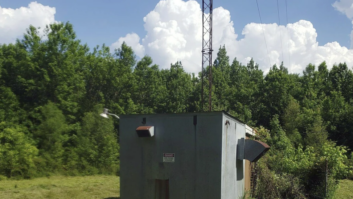
From the Radio Show — provided by the FCC.
FCC Commissioner Ajit Pai gave this speech at the Radio Luncheon, Sept. 20, at the 2013 Radio Show.
Since joining the FCC last year, I’ve had the privilege of visiting many radio stations across the United States. I’ve been to our nation’s oldest commercial radio station, KDKA in Pittsburgh, Pa. I’ve visited the country’s northernmost station, KBRW in Barrow, Alaska. And I’ve seen the nation’s top-grossing station, WTOP in Washington, which is operated by Ginny Morris, this afternoon’s recipient of the National Radio Award.
As you might imagine, these stations differ in many ways. KBRW, for instance, probably wouldn’t mind having WTOP’s budget. And given that KBRW is one of only two stations in Barrow, WTOP probably wouldn’t mind having KBRW’s market share. But in one way — probably the most important way — these stations are all the same. Each of them is committed to serving its local community.
Localism is a word that is thrown around a lot at the FCC. We’ve had a localism task force, a localism proceeding, localism reports … you get the picture. We talk about localism so much that it can sometimes seem like just a word to us. But not to radio broadcasters. Localism isn’t an abstraction to you. It’s your business plan; it’s your lifeblood.
A meeting with one radio broadcaster drove home that point to me earlier this year. The man was Brian Winnekins. He lives in Durand, Wisconsin, a small town of 1,900 people between Madison and Minneapolis. In 2012, he and his wife brought WRDN, Reel Country 1430 AM, back to life after five years of radio silence.
When he visited my office, Brian gave me a packet of letters from Durand residents explaining what WRDN meant to them. He asked me to look at them when I had the time. I’m not sure if he actually expected me to read them, but I did. And what I found was revealing. The superintendent of the Durand School District wrote to tell me that WRDN covered Durand High School athletic events. An official with the Durand fire department discussed the importance of having a local radio station to broadcast emergency information. A pastor explained how WRDN aired his church’s weekly worship service for those who were homebound and couldn’t attend in person. One resident put it well when he wrote that when WRDN was off the air before 2012, “a sense of community was partially lost.”
As Brian told me about his experiences operating WRDN, he became choked up. And while his words influenced me, his emotions had a more profound effect. They showed his passion for community service in a way that no speech could. (Ed. Note: Read a commentary about the meeting by Brian Winnekins.)
Brian’s commitment to community service isn’t unique. Broadcasters contribute every day. I was honored to see this for myself this past summer at the Celebration of Service to America Awards presented by the NAB Education Foundation. (By the way, that evening was also memorable for me because I gave out an award alongside Miss America, something I thought it was best to tell my wife about after the fact.) All of the awards showed broadcasters at their best: informing the community, helping the community, being a part of the community. That kind of commitment to localism and service makes the future of broadcasting bright.
Of course, not everyone agrees. There are some who seem to say “broad” only if it is followed by “band.” There are some who openly question the future of broadcasting, who seem to think that Americans who rely on broadcasting every day are stuck in the past. But I’ve said it before and I’ll say it again: Broadcast and broadband are complements, not substitutes.
What does this mean for the FCC? It’s simple. The FCC should take a comprehensive view of the communications industry and focus on the issues confronting both the broadcast and the broadband sectors. Or, to put it another way, we need to be able to walk and chew gum at the same time. Broadcasting shouldn’t be an afterthought; it isn’t for the American people.
When I joined the FCC, it quickly became apparent that the relationship between the agency and broadcasters wasn’t as good as it could have been. But in the last 16 months, I believe that things have become better. Chairwoman Clyburn, Commissioner Rosenworcel, and I each value the important role that broadcasters play in today’s media marketplace.
Earlier this year, for example, the FCC held hearings to examine the state of communications during public safety emergencies, and we heard firsthand how Americans turn to broadcasters when disaster strikes. If the power goes out, if the Internet goes down, and if wireless networks fail, you can still turn on your battery-powered radio to get the information that you need.
The proof is in the Arbitron ratings. To give one of many examples, as Superstorm Sandy made landfall last October, radio listenership in the New York City market increased 70% above the prior week. The jump was even higher in coastal areas, with audiences skyrocketing by 367% along the Connecticut coast and 245% on Long Island.
Radio doesn’t just matter in emergencies. In 2002, 92% of Americans listened to broadcast radio each week. And what about now, in the age of podcasts and Pandora and iTunes and Spotify? The number hasn’t budged — 92% of Americans still tune in each week.
So when I look at the radio industry as a whole, I see relevance, resilience, an ability to adapt to the demands of the modern media marketplace. I see an industry poised for growth. But I do have a special concern about one part of the dial — AM radio. When I was born, AM radio accounted for approximately half of all listening. Today it’s less than 20%. The number of AM stations is declining, and every day it seems harder to receive a quality AM signal.
But the last time that the FCC comprehensively reviewed its AM radio regulations, Casey Kasem was still counting down the top 40 hits, urging us to keep our feet on the ground and keep reaching for the stars. The year was 1991, the #1 song was “Emotions” by Mariah Carey, the FCC Chairman was Alfred Sikes, and both the Kansas City Royals and Pittsburgh Pirates finished the season with winning records (imagine that).
Last year at the Radio Show in Dallas, I said that it was once again time for us to take a hard look at our AM radio rules. I proposed that the FCC launch an initiative to revitalize AM radio. Now, I’ve blathered a lot since joining the Commission, and in all that blather I’ve tried to offer a bunch of ideas on everything from modernizing cable regulation to speeding up the FCC’s decision-making. But the reaction to my call for an AM radio revitalization initiative, like AM radio itself, has been one of a kind.
Over the course of the last 12 months, my office has been flooded with good suggestions for what the FCC should do to help the AM band. Operators of the biggest stations in our country as well as small day-timers in rural America have shared their ideas with me. Engineers have picked up the phone and offered their advice. Dedicated listeners have sent emails and tweets voicing their support. Even the Royals and Pirates have cooperated, with each slated to finish in the black for the first time since 1991.
And for anyone who thinks AM is a forgotten backwater, think again — even media attention is growing. Less than two weeks ago, for example, the cause of AM radio revitalization made it all the way to the front page of the New York Times. (I was somewhat amused to see that a story about the FCC and “net neutrality” rules that same day was relegated to a back section.)
I’m gratified and a bit amazed by the response my proposal has received. The conversation that’s taken place over the last year has been very helpful in generating ideas. But talk alone isn’t going to get the job done. We have a lot of work to do. I couldn’t put it better than the late, great comedian John Candy: “There’s a time to think, and a time to act. And this, gentlemen, is no time to think.”
That’s why I am so pleased that Chairwoman Clyburn on Wednesday circulated to the other Commissioners a draft order addressing AM revitalization. The draft order seeks public input on proposed changes to our AM radio rules. For this and many other reasons, I’m very thankful to Chairwoman Clyburn for her leadership.
Once the FCC formally proposes changes to revitalize AM, it’ll be your turn. If you agree that AM remains important, that the FCC can help save the band, I encourage you to make your voice heard. Let us know what you think of our proposals. Which ones do you support? Which ones raise concerns? What other ideas that aren’t mentioned should we be considering? To get this right, we need your input.
In the short term, we’ll need to act quickly to provide AM broadcasters with relief while we come up with more permanent fixes for the band’s difficulties. One simple but important concept would be to make it easier for broadcasters to improve their signals and find suitable antenna sites. To give just one example, I’ve heard repeatedly that the AM ratchet rule is an unnecessary regulation that deserves to be repealed.
We should also make it easier for AM stations to get and use FM translators. In 2009, the FCC amended its rules to allow AM stations to be rebroadcast on FM translators. I’ve heard firsthand how this step has been a lifeline for many AM broadcasters. But I’ve also heard from countless station owners who are frustrated by their inability to get a translator. A petition is currently pending at the Commission to make it easier for AM stations to move FM translators, and I support that effort. But the FCC should go further — we should open up a window where any AM station without an FM translator can obtain one so long as there is available spectrum.
Proposals like these can be a bridge to the AM band’s future. But as we go about building that bridge in the coming months, we also need to continue thinking about what will sit on the other side: the long-term future of AM. There isn’t a consensus on the steps we need to take for the AM band to be alive and well 10 or 15 years from now.
Now, I don’t claim to have the answer at this point either. But I do think that there are two important principles that should guide us going forward. First, you — the AM broadcasters — need to keep in mind that you are all in this together. I know that there are some ideas that smaller broadcasters like more than larger broadcasters and vice versa. What all AM broadcasters need, however, is a package of reforms that will work for everyone. Both large and small broadcasters are vital to the band. On the other hand, if too many broadcasters allow the perfect to become the enemy of the good, our efforts could be doomed by infighting. That’s why we need a balanced approach that will allow both larger stations and smaller stations to thrive.
Second, we have to welcome new ideas and set aside conventional wisdom. The recent New York Times story on AM revitalization was accompanied by a photo of Franklin Delano Roosevelt, who used to give fireside chats over AM radio during his presidency. Now, as a good Republican, I would have preferred it had the Times chosen a different photo: perhaps, Calvin Coolidge, the first President to give an address over AM radio, or Ronald Reagan, who broadcast Chicago Cubs games for WHO(AM) in Des Moines, Iowa. But I do think that we can look to FDR for some guidance when it comes to AM revitalization.
As a candidate for the Oval Office, Roosevelt said that the times called for “bold, persistent experimentation.” And that’s exactly what we need to secure the future of the AM band. We should continue testing digital AM radio. We should allow for tests of synchronous transmission systems. We should be open to tests involving changes to nighttime power levels. And we should encourage other innovative ideas too. To be clear, I don’t believe that we at the FCC should take our inspiration from Cole Porter and say “Anything Goes.” But I do think that we should have a very open mind.
Oh, one other thing. I’m well aware that some are skeptical of efforts to revitalize the AM band. I’ve even heard the word “quixotic” mentioned once or twice. But those of you in the radio industry have heard the doom-and-gloom predictions before. In fact, all the way back in 1897, Lord Kelvin, a prominent physicist and president of the British Royal Society, boldly declared: “Radio has no future.” Well, you’ve proved the critics wrong in the past, and I’m confident that you can prove them wrong once again.
To close, I’m often asked why we should care about the future of AM radio? It’s an important question, so let me answer it here. If you care about diversity, you should care about AM radio. Most minority-owned radio stations are located in the AM band. So are many stations aimed at ethnic and foreign-language minority populations. If you care about localism, you should care about AM radio. Many AM radio stations cover local news, weather and community events. And if you care about an engaged citizenry, you should care about AM radio. Many AM radio stations provide a vital forum for discussing the issues of the day. These reasons, among others, are why I believe that the future of AM radio is worth fighting for.
Whether it’s AM or FM, you have a lot to be proud of when it comes to radio’s past. And I look forward to working with you to ensure that radio’s future remains bright. In the 16 months that I’ve had the privilege of serving at the FCC, I’ve seen and heard firsthand what radio means to the American public. I’m committed to doing what I can to preserve that unique bond between broadcasters and listeners. Thank you for inviting me to speak with you this afternoon, and stay tuned.











